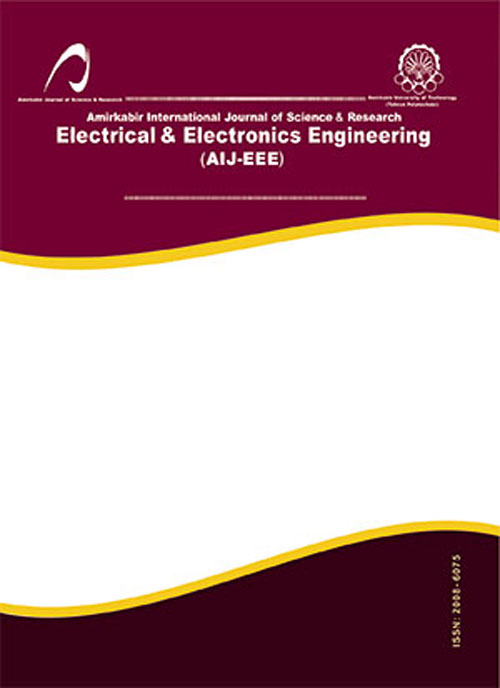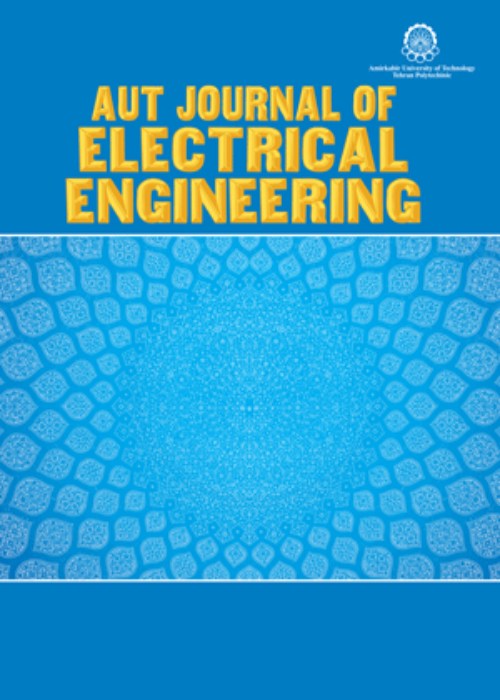فهرست مطالب

Amirkabir International Journal of Electrical & Electronics Engineering
Volume:47 Issue: 2, Summer - Autumn 2015
- تاریخ انتشار: 1394/09/30
- تعداد عناوین: 6
-
-
Pages 1-8Collaborative Spectrum Sensing (CSS) is an effective approach to improve the detection performance in Cognitive Radio (CR) networks. Inherent characteristics of the CR have imposed some additional security threats to the networks. One of the common threats is Primary User Emulation Attack (PUEA). In PUEA, some malicious users try to imitate primary signal characteristics and defraud the CR users to prevent them from accessing the idle frequency bands. The present study investigates a new CSS scheme in the presence of a smart PUEA, which is aware of idle frequency channels and transmits its fake signal in a way that CR users are not easily able to discriminate between the received signal from the PU and PUEA. The idea is based on the Bayes risk criterion. More precisely, the sensing results of the CR users are summed up in the Fusion Center (FC) and compared with the optimum threshold that minimizes the Bayes risk. We also discuss practical limitation issue that need to be considered when applying the proposed method. Simulation results are provided to indicate the superiority of the proposed method against PUEA compared with conventional method.Keywords: Cognitive Radio, Cooperative Spectrum Sensing, Primary User Emulation Attack, Optimum Threshold, Bayes Risk
-
Pages 9-17Power amplifiers (PAs) are inherently nonlinear elements and digital predistortion is a highly cost-effective approach to linearize them. Although most existing architectures assume that the PA has a memoryless nonlinearity, memory effects of the PAs in many applications, such as wideband code-division multiple access (WCDMA) or orthogonal frequency-division multiplexing (OFDM), can no longer be ignored and memoryless predistortion has limited effectiveness. In this paper, a novel digital predistorter based on the Hammerstein structure has been proposed for linearization of radio frequency power amplifiers with memory effect. Designing the Hammerstein model based digital predistorter has been done using an accurate Wiener model of the power amplifier. The proposed digital predistorter has many advantages such as low computational complexity, low memory space and simple implementation. The elimination of nonlinear effects and constructing accurate behavioral model, which is the exact inverse of a power amplifier characteristic, have been demonstrated by simulating 64 QAM constellation diagram in Matlab. In order to validate the proposed predistorter, it is implemented in Kintex FPGA using Vivado HLS and acceptable results have been obtained.Keywords: Power Amplifiers (PAs), Wiener, Hammerstein model, Digital Predistorter (DPD), Linearization, Field Programmable Gate Array (FPGA)
-
Pages 19-25Resource allocation techniques have recently appeared as a widely recognized feature in LTE networks. Most of existing approaches in resource allocation focus on maximizing network’s utility functions. The great potential of utility function in improving resource allocation and enhancing fairness and mean opinion score (MOS) indexes has attracted large efforts over the last few years. In this paper, a new fairness index is proposed to measure resource allocation performance for real-time/delay-tolerant applications. This index can suggest a new approach for resource allocation. There are several methods in resource allocation of cellular networks which employ fairness index for performance evaluation. Here, we focus on utility-function-based resources allocation and related algorithms. According to the suggested method, the base station (BS) allocates resources based on different services requirements. Appropriate utility function for each application is defined, and the requested quality-of-services (QoS) are satisfied through solving the corresponding optimization problem. The new well-defined fairness index shows that the proposed method has a good performance for different real-time/delay-tolerant applications. Additionally, numerical results show that this approach is able to improve other important indicators such as throughput and MOS as well.Keywords: Resource Allocation, Fairness Index, MOS, Throughput, Utility Function
-
Pages 27-37The produced electric and magnetic fields due to lightning strikes to mountainous ground are determined in this paper. For the sake of simplicity a cone-shaped ground with finite conductivity is assumed to represent a natural nonflat ground. By this assumption, we deal with an axillary symmetrical structure so we use the cylindrical 2D-FDTD to save the simulation memory and time, dramatically. The return stroke channel is modeled using the antenna theory model with fixed inductive loading (ATIL-F) which is appropriately incorporated into the FDTD algorithm. We have derived the updating equations of 2D-FDTD for distributed resistance and inductance in ATIL-F model. Both the first and the subsequent return strokes are considered and their related radiated electromagnetic fields are determined and compared with each other. The fields are calculated at an intermediate horizontal distance from the cone-axis. The calculated results show that the presence of the cone-shape ground introduces an enhancement in electric and magnetic fields, for both first and subsequent return strokes. Since sharper lossy cone means larger current density in the ground, the increment in the amplitude of the fields is inversely proportional to the cone-angle. A hump is observed in electromagnetic field waveforms because of the current reflection form joint point of the cone-shape ground and the flat ground beneath it. It is more specific in the subsequent-stroke fields. simulation results for different cone-height are presented. It shows that for small values of height, the results approaches to those of the flat ground.Keywords: Lightning, Mountainous ground, Return stroke, ATIL model, Cylindrical 2D, FDTD
-
Pages 39-47This paper presents a formulation of unit commitment for thermal units integrated with wind and solar energy systems and electrical vehicles with emphasizing on Mixed Integer Nonlinear Programming (MINLP). The renewable energy resources are included in this model due to their low electricity cost and positive effect on environment. As well as, coordinated charging strategy of electrical vehicles and reasonable usage of V2G power can reduce the generating cost. Electric vehicles and renewable energy resources are the most promising options for alternative sources in the near future. The proposed method is solved using MINLP solver in GAMS software. The problem is finding a solution which satisfies the constraints and minimizes the objective function. As a case study, results on IEEE ten-unit system are presented in this paper. The numerical tests and results showing that their inclusion with the conventional power generating sources reduces the operational cost and greenhouse gas emissions were presented in electric power industry.Keywords: Unit commitment, Generation scheduling, Renewable energy resources, Vehicle to grid, MINLP method
-
Pages 49-60In this paper, the impacts of installing superconducting fault current limiter (SFCL)in radial and loop power distribution system are evaluated to improve voltage sag in both cases of with and without distributed generations (DG). Among various SFCLs, the hybrid type with a superconducting element in parallel with a current limiting reactor (CLR) is selected. This is more effective than resistor-type SFCLs because it reduces the burden on the superconducting element, ac losses and cost in distribution system. According to SFCLs impedance and their locations in power system, voltage sag will be improved by reducing the fault current. In this paper, SFCLs with various arrangement and CLR magnitudes are installed in distribution system and improving the voltage sags on different buses are examined according to fault position. Area of severity (AOS) method and expected annual sag frequency (ESF) are used to analyze the voltage sag. The results show that installing SFCL can improve the voltage sags as well as fault current reduction in radial and loop distribution systems.Keywords: Superconducting Fault Current Limiter (SFCL), Voltage Sag, Radial, Loop Distribution System, Distributed Generation


